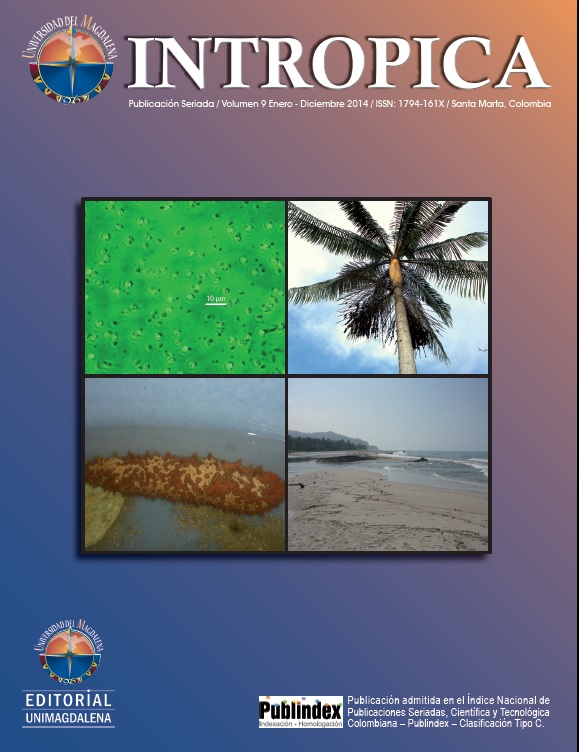Efecto del fotoperiodo sobre el crecimiento de la diatomea Chaetoceros calcitrans (clon c-cal) en cultivos estáticos
Contenido principal del artículo
Resumen
Descargas
Detalles del artículo
Citas
Alvarez, H. 1994. Introducción al Método Ficológico. Capitulo III. Escuela Superior Politécnica del Litoral, Ecuador 375 p.
Alveal, M., E. Ferrario., E. Oliveira y E. Sar. 1995. Manual de Métodos Ficológicos. Universidad de Concepción, Concepción, Chile 863 p.
Becker, W. 2004. Microalgae for Aquaculture: The Nutritional value of Microalgae for Aquaculture pp. 380-391. En: Richmond A (Ed). Handbook of Microalgal culture: Biotechnology and Applied Phycology. Blackwell, Oxford, London. 588 p.
Bermudez, J. L., C. Ladeiros y E. Morales. 2002. Producción de biomasa de la microalga marina Chroomonas sp., en función del pH, intensidad luminosa y salinidad. Boletin de Investigaciones Marinas y Costeras 31:167-185.
Borowitzka, W. 1999. Economic evaluation of microalgal processes and products. pp. 387-409. En: Cohen Z. (ed.), Chemicals from microalgae. Taylor & Francis: London. 419 p.
Boyd, C. E. y D. Gautier. 2000. Effluent composition and water quality standards. Global Aquaculture Advocate 3 (5): 61 – 66.
Brown, M., S. Jeffrey, J. Volkman y G. Dunstan. 1997. Nutritional properties of microalgae for mariculture. Aquaculture 151: 315-331.
Cáceres, S. O. 2009. Aislamiento y Caracterización de las Principales Microalgas presentes en el sistema hidropónico del tipo raíz flotante. Universidad de Chile, Santiago, Chile 60 p
Díaz, V. y C. Ordoñez. 2006. Evaluación del pH y la agitación del medio más adecuada para el crecimiento de Dunaliella salina en condiciones de laboratorio. Tesis de pregrado. Pontificia Universidad Javeriana, Bogotá, Colombia. 84 p.
Ferrero, I. 2011. Producción de biodiesel a partir de microalgas como alternativa a los cultivos clásicos. Monografía Universidad Nacional del Litoral. Santa Fé. Argentina. http://institutoideal.org/ecologicas/wp-content/uploads/2012/08/03-Ignacio-Ferrero.pdf
Fogg, G. E. 1965. Algal cultures and phytoplankton ecology. The University of Wisconsin Press. Madison. 175 p.
Guillard, R. L. 1975. Culture of phytoplankton for feeding marine invertebrates. pp 29-59. En: Smith, W. L y M. H. Chanley (Eds). Culture of marine invertebrate animal. Plenum Press. New York. 329 p.
Humprey, G. F. 1979. Photosynthetic characteristics of algae grown under constant illumination and light-dark regimes. Journal of Experimental Marine Biology and Ecology. 40: 63-70.
López, J. A., N. García, L. Jiménez y N. Huerta. 2009. Crecimiento de la diatomea Thalassiosira pseudonana en cultivos estáticos con iluminación continua y fotoperiodo a diferentes salinidades. Biotecnia. 52:113-22.
Mora, R., R. Moronta., J. Ortega y E. Morales. 2005. Crecimiento y producción de pigmentos de la microalga nativa Chlorella sp aislada de la represa de Tulé, Municipio de Mara, Estado de Zulía, Venezuela. Ciencia. 12 (2): 1-9.
Murray, L., A. Raab y J. Feldmann. 2003. Biotransformation of arsenate to arsenosugars by Chlorella vulgaris. Applied Organometallic Chemistry, 17: 669-674.
Prieto, M., M. Mogollón, A. Castro y L. Sierra. 2005. Efecto del medio y condiciones de cultivo en la producción de tres diatomeas marinas con potencial acuícola. Revista MVZ Córdoba, 10: 544-554.
Sánchez-Saavedra, M. P. y D. Voltolina. 1994. The chemical composition of Chaetoceros sp. (Bacillariophyceae) under different light conditions. Comparative Biochemistry and Physiological Part B: Biochemistry and Molecular Biology. 107: 39-44.
Tzovenis, I., De Pauw N y P. Sorgeloos. 2003. Optimization of T-ISO biomass production rich in essential fatty acids I. Effect of different light regimes on growth and biomass production. Aquaculture 216: 203-222.
Uribe, E. 1994. “Cultivo de peces marinos” - Cultivo de Microalgas, material docente. Departamento de Acuicultura. Facultad de Ciencias del Mar. Universidad Católica del Norte. Coquimbo. Chile: 50- 73.
Velasco. L. A., S. Carrera y J. Barros. 2009a. Producción de microalgas como alimento para pectínidos. Cap 2. Biología y cultivo de Pectínidos de interés comercial de Colombia. ed: Fondo Editorial Universidad Del Magdalena. 258 p.
Velasco, L., J. Barros-Gómez., G. Ospina-Salazar y C. Trujillo. 2009b. Efecto de la intensidad lumínica, temperatura y salinidad sobre el crecimiento de la microalga Isochrysis galbana (clon t-iso). Revista Intropica 4: 93-99.
Viramontes-Robles, F. 1991. Estudio del efecto de diferentes ciclos luz-oscuridad sobre el crecimiento y contenido de lípidos en tres especies de microalgas marinas. Tesis de licenciatura. Departamento de Ciencias Químico Biológicas. Universidad de Sonora. 46 p.
Wikfors, G. H y M. Ohno. 2001. Impact algae research in aquaculture. Journal of Phycology. 37:968-974.

